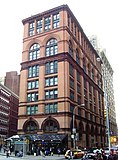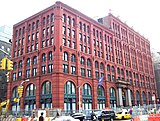Lafayette Street (Manhattan)
The Lafayette Street is a main road in the south of the district Manhattan in the US city of New York City .
Location and course
Lafayette Street extends north-south through Lower Manhattan and runs roughly parallel to Broadway to the west . Originally called the portion of the road, south of Houston Street lies Elm Place .
The street starts from the south where Reade Street and Center Street intersect - one block north of New York City Hall . The one-way street then runs north through the neighborhoods Chinatown , Little Italy , Nolita and NoHo . Finally, she goes between 9th Street and 10th Street in the Fourth Avenue on. A separate bicycle lane runs on the left side of the road.
Local transport
The IRT Lexington Avenue Line subway runs under Lafayette Street and stops on Canal Street , Spring Street , Bleecker Street and Astor Place .
history


The ground on which the road was running at first the subject of real estate speculation of John Jacob Astor , who acquired the previously existing there large nursery in 1804 for $ 45,000 and the reason to a French Names Joseph Delacroix leased, which it into a pleasure garden with adjoining theater made : New York Vauxhall Gardens modeled on the famous Vauxhall Gardens on the outskirts of London .
When the lease expired in 1825, Astor built a new road in the middle of the property - a cul-de-sac that began at Astor Place and was three blocks long. He named this dead end Lafayette Place to commemorate a hero of the American Revolutionary War : Marie-Joseph Motier (Marquis de La Fayette) , who was visiting America again at the time and was enthusiastically celebrated there.
The lots on either side of the new road sold quickly, grossing Astor many times what he paid for that land two decades earlier. The most magnificent Greek Revival building was "LaGrange Terrace" on the west side of the street, which was built in 1833 - now known as " Colonnade Row " because of the Corinthian order columns , which were two stories high in front of the nine row houses behind and a unified one Facade formed. Each of these nine townhouses cost $ 30,000 at the time. Today only four of them are preserved and are under monument protection. They are the only remaining witnesses to the first exclusive phase of Lafayette Street, which was given this name when the city extended the street to the south, thereby removing the dead-end character.
The end of the glamorous times of this area was heralded with the departure of William Colford Schermerhorn in 1860, who lived there with his family in the Schermerhorn Mansion . Mrs. Schermerhorn set up the family seat in 1854 in the Versailles style under Louis XV. came here to hold a magnificent costume ball with the motto "France" for 600 New Yorkers. When the Schermerhorns moved north to 49 West 23rd Street six years later , half of Colonnade Row was demolished shortly thereafter to make way for a warehouse for Wanamaker's department store. Wanamaker's had taken over the palatial textile store from AT Stewart in the immediate vicinity , which took up the entire block between Broadway and Lafayette Streets and 9th and 10th Streets . At the same time, he built an equally large extension right next door between 8th Street and 9th Street with a footbridge between the two buildings. The main building burned down in 1956, but the annex and warehouse remain on Lafayette Street. In 1888 the stately Schermerhorn Mansion was finally torn down and replaced by the Schermerhorn Building, which was rented to a clothing manufacturer.
Attractions
Sights along Lafayette Street include:
- The New York Mercantile Library from 1891 on Astor Place (architect: George E. Harney ), where the Astor Opera House was once located and now houses condominiums.
- Alamo or Astor Place Cube - a cube-shaped sculpture on Astor Place
- Astor Library Building (1854) - founded by John Jacob Astor. Today the Public Theater is located there .
- Colonnade Row (1833): Today four of the original nine row houses in the Greek Revival style are still standing . One of them is now the Astor Place Theater .
- The Schermerhorn Building , built for the Schermerhorn family in 1888, based on plans by Henry Janeway Hardenbergh , to replace the Schermerhorn Mansion.
- The War Resisters League and the NoHo Star on Bleecker Street
- The Puck Building on East Houston Street
- The New York City Rescue Mission on White Street
- The fire station (87 Lafayette Street at the intersection with White Street) was built in 1895 according to plans by Napoleon LeBrun . Today the Downtown Community Television Center is located here .
- The Ahrens Building of George Henry Griebel and the City Municipal Court Building on the south side of the White Street
- New York City Courts on Franklin Street
- The Department of Health, Hospitals and Sanitation on Leonard Street
- Federal Plaza with the Jacob Javits Federal Building on Worth Street
- The Foley Square (named after Tammany Hall's "Big Tom" Foley) at the Pearl Street
"Summer streets"
For three Saturdays in August 2008, the New York City Department of Transportation closed Lafayette Street, Park Avenue, and part of East 72nd Street to vehicle traffic as a Summer Streets Program for the Advertise Auto Waiver. This event was repeated on August 8, 15 and 22, 2009 - from seven in the morning to one in the afternoon. In 2010 this took place on August 7, 14 and 21.
gallery
The New York Mercantile Library was housed in the "Clinton Hall" on Astor Place . This is where the Astor Opera House once stood , where the Astor Place Riot began in 1849 .
The Puck Building - formerly the Puck Magazin printing house - was designed by Albert Wagner.
Individual evidence
- ^ A b Moscow, Henry: The Street Book: An Encyclopedia of Manhattan's Street Names and Their Origins New York: Hagstrom 1978. ISBN 0-8232-1275-0 , p. 67
- ↑ Burrows, Edwin G. & Wallace, Mike (1999): Gotham: A History of New York City to 1898. New York: Oxford University Press. ISBN 0-19-511634-8 , p. 448
- ↑ Burrows, Edwin G. & Wallace, Mike (1999): Gotham: A History of New York City to 1898. New York: Oxford University Press. ISBN 0-19-511634-8 , p. 723
- ^ Morris, Lloyd R. Incredible New York: Life and Low Life of Last Hundred Years 1979, pp. 17-19
- ↑ Schermerhorn genealogy .
- ↑ New York Songlines ( Memento of the original from June 10, 2009 in the Internet Archive ) Info: The archive link was inserted automatically and has not yet been checked. Please check the original and archive link according to the instructions and then remove this notice.
- ↑ Summer Streets
Web links
- Lafayette Street Storefronts - Photographs of the buildings and shops along Lafayette Street
- New York Songlines: Lafayette Street (English)







